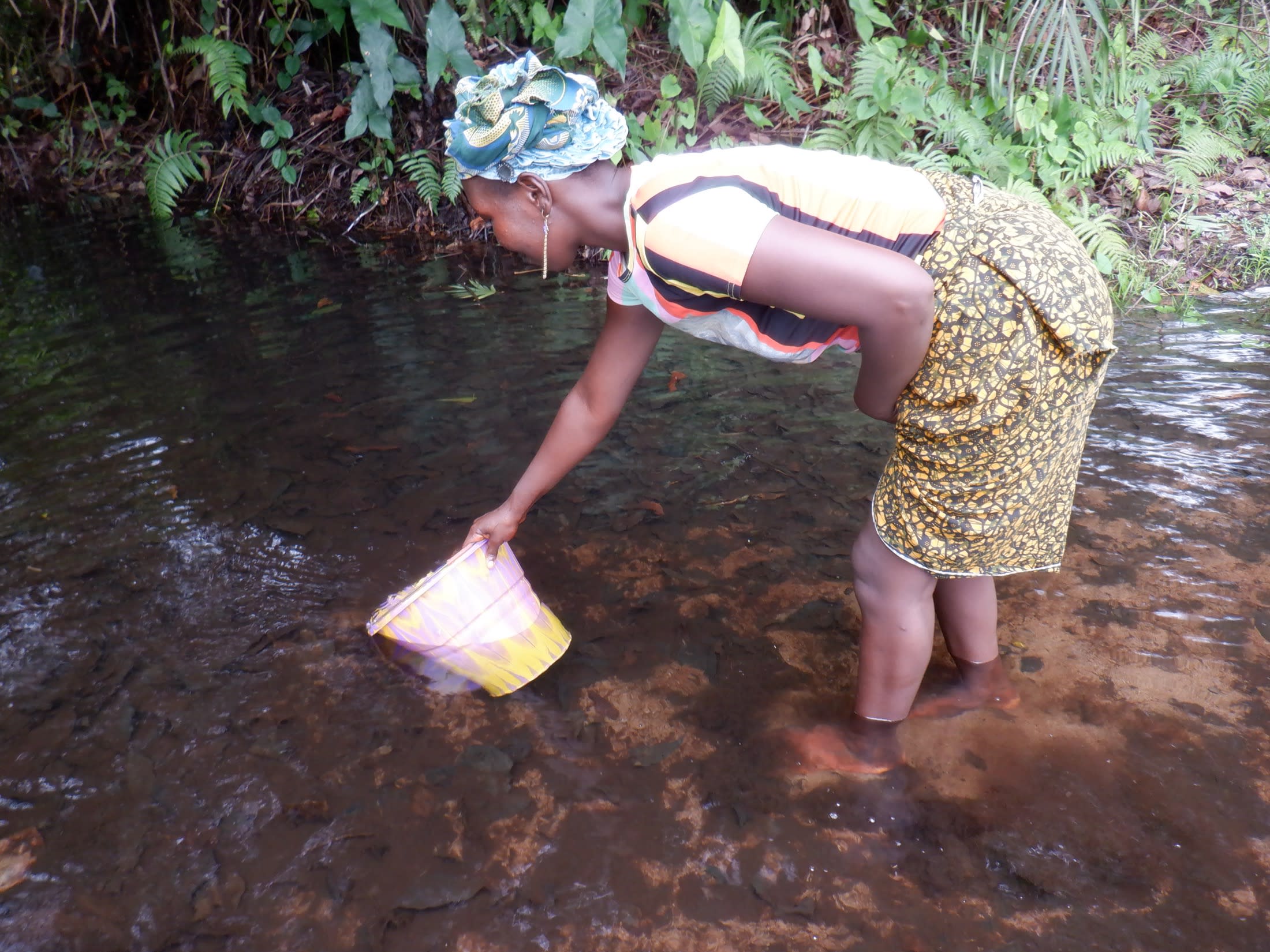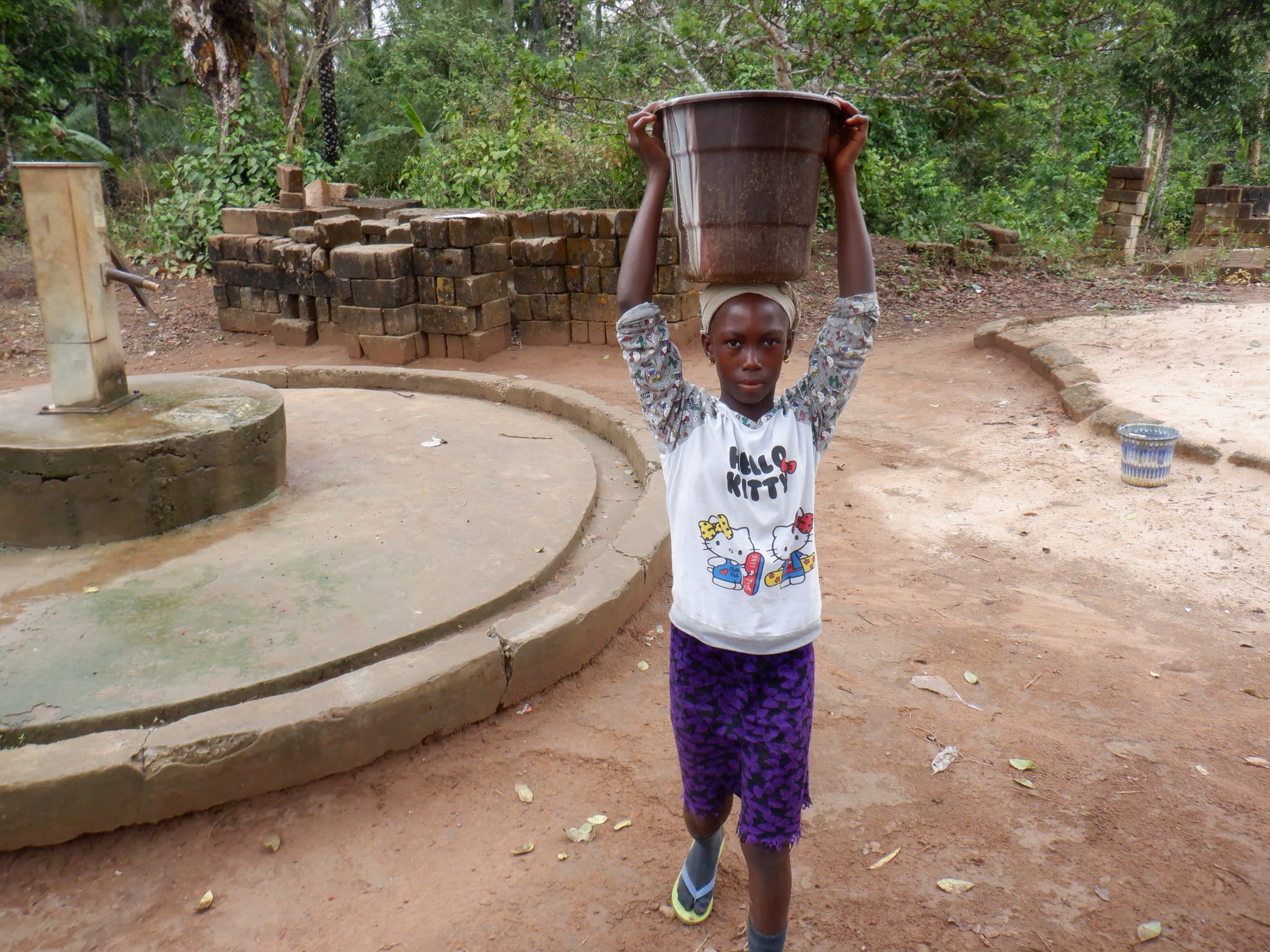March, 2023: Santiguiya Neneh Community Borehole Well Complete!
We are excited to share that there is now a safe, reliable borehole well at Santiguiya Neneh Community. As a result, community members no longer rely on unsafe water to meet their daily needs. We also conducted hygiene and sanitation training, which focused on healthy practices such as handwashing and using latrines.
"I am happy today because I have access to safe drinking water in my community," said 12-year-old Emma. "Before, it was a burden on me to fetch water home, and the distance to the stream is far. After making many trips, I [would] get tired because I [had to] walk a long distance to get the jerrycans home. I always worried to go down the stream, and [its] water is not safe to drink. But today [you have provided] new water in my community, and I want to say thanks. [I will have] no more worries in fetching water."

Emma, right, splashes water at the new well.
"Today, it is a great privilege for me to have access to clean and safe water to drink in my community," said 28-year-old farmer Isatu Kamara, whom we interviewed on our first visit to Sanitiguiya Neneh.

Isatu cups her hands beneath the well.
"[In] the past, I [would] get access to stream water, but this water is not safe to drink," Isatu continued. "It is open to contamination, and there is a lot of dirt in the water. During the rainy season, this water becomes more dirty because all the rubbish is deposited into the water, and when I drink this water, I experience waterborne disease. Now I want to thank [everyone for providing] a new borehole well in my community. The well is fenced, and the water that is coming out is clean. Drinking such water will impact my life because I will not contract waterborne diseases. With the help of this water point, I will complete my housework on time."
We held a dedication ceremony to officially hand over the well to the community members. Several local dignitaries attended the ceremony, including representatives from the Port Loko District Council, the Ward Council, and the Ministry of Water Resources. Each official gave a short speech thanking everyone who contributed to this water project and reminding everyone to take good care of it. Then, Emma and Isatu made statements on their community's behalf. The ceremony concluded with celebration, singing, and dancing.

Emma, left, dances alongside Osman Fofanah from the Ministry of Water Resources.
New Well
The drill team arrived the day before beginning work. They set up camp and unpacked all their tools and supplies to prepare for drilling the next day. The community provided space for the team to store their belongings and meals for the duration of their stay. The following day, work began.

Our team dug two pits next to the drill rig, one for the drill’s water supply and another for what the drill pulls out of the borehole. In some cases, we order a private supplier to deliver the water for drilling since water access is already challenging.
Day one of drilling began as the team mixed water with bentonite, an absorbent clay, in the two dug pits. Next, the team fixed a four-inch carbide-tipped bit to the five-foot-long drill stem. They started the mud pump to supply water to the drill rig so that drilling could begin!

After putting each five-foot length of drill stem into the hole, the team took material samples. We labeled the bags to review them later and determine the aquifer locations.
On the second day of drilling, the team expanded the hole and cleared it of mud. After reaching a total depth of 21 meters, the team forcefully pumped clean water into the well to remove any dirt and debris from the drilling process. We then protected the screened pipe by adding a filter pack. The team hoisted the temporary drilling casing to fortify the pipes with cement.

Yield test.
Next, we bailed the well by hand for three days before conducting a yield test to verify the water quantity. This well has a static water level of ten meters. With these excellent results, we installed a stainless steel pump. Water quality test results showed that this was clean water fit for drinking!

New Knowledge
Before conducting any hygiene training, we called and visited the local water user committee to understand the community’s challenges and lack of sanitation facilities. We shared the findings from our discussions with the committee members to help them make the necessary adjustments before the training began. For example, we identified households without handwashing stations or ones that may need to repair their latrines. With this information, community members worked together to improve hygiene and sanitation at home.
We also invited a nurse from the local clinic to help explain some topics and spread awareness about Sierra Leone's free vaccinations for children under five. Nurse Fatmata was instrumental in reinforcing each lesson.
After this preparatory period, we scheduled a time when members from each household using the water point could attend a three-day hygiene and sanitation training. We then dispatched our teams to the agreed-upon location to hold the meeting.

Handwashing lesson.
Training topics covered included handwashing and tippy taps, good and bad hygiene habits, disease transmission and prevention, COVID-19, worms and parasites, proper dental hygiene, proper care of the well's pump, keeping the water clean, the cost recovery system, the importance of using dish racks and clotheslines, the importance of toilets, keeping latrines clean, balanced diets, the diarrhea doll, and HIV and AIDS.
When we started discussing good versus bad hygiene practices, one community member named Ramatu stood up and said that, based on the advice from our in-country team, she had already installed essential hygiene and sanitation household features like a latrine and dish rack.

Nurse Fatmata explains good versus bad hygiene practices.
"There has been a decline in the number of sick cases (typhoid, malaria) we were experiencing before due to poor sanitation," Ramatu said. "The team really deserves a round of applause because they are doing a good job. Therefore, I want to encourage all of us to listen carefully to the remaining lessons so that we would be able to learn and improve our lives. We can even serve in the capacity to tell others about what we have learned. Let us ensure we put into practice what we have learned because this would be beneficial for us all."
Another topic that prompted a lot of discussion was pregnancy, along with prenatal and postnatal care. As there are many women in Santiguiya Neneh who have recently given birth, they were particularly interested in learning about this topic. Nurse Fatmata explained that this time is critical for the health of both mother and baby and emphasized the need for mothers to visit a hospital or clinic before, during, and after the birth of a baby. By the end of the discussion, everyone understood the importance of detecting health problems in newborns and pregnant mothers as early as possible.
"Honestly, right from the baseline survey, I observed that one of the team members from this organization took a photo of our drinking container," said community member Kabba Kamara, who gave up some of his land for us to install this water point.

Kabba on one of the training days.
"I never knew that placing a drinking container on the floor would create chances for contamination. But due to this hygiene and sanitation training, I gained an understanding of the implication of such actions. I was able to see the importance of handling my drinking container with care during the hygiene training. One of the pictures that was used to present the lesson on good/bad hygiene shows a woman that was sweeping, and the drinking containers are on the floor. This was a risk factor because some of the containers are not covered, and this would create room for dust to get into the container. From this lesson, I have learned that drinking water must be on top of the table so that children and even domestic animals would not gain access to it easily. Drinking water must be changed every day, and the container must be washed thoroughly with soap and clean water. Therefore, I want to say thank you to the team for this knowledge I received because I was totally ignorant about this."
Conclusion
This project required a substantial collaboration between our staff, our in-country teams, and the community members themselves. When an issue arises concerning the well, community members are equipped with the necessary skills to rectify the problem and ensure the water point works appropriately. However, if the issue is beyond their capabilities, they can contact their local field officers to assist them.
Also, we will continue to offer them unmatchable support as a part of our monitoring and maintenance program. We walk with each community, problem-solving together when they face challenges with functionality, seasonality, or water quality. Together, all these components help us strive for enduring access to reliable, clean, and safe water for this community.
With your contribution, one more piece has been added to a large puzzle of water projects. In our target areas, we’re working toward complete coverage of reliable, maintained water sources within a 30-minute round trip for each community, household, school, and health center. With this in mind, search through our upcoming projects to see which community you can help next!
Thank you for making all of this possible!




 Borehole Well and Hand Pump
Borehole Well and Hand Pump
 Rehabilitation Project
Rehabilitation Project





























